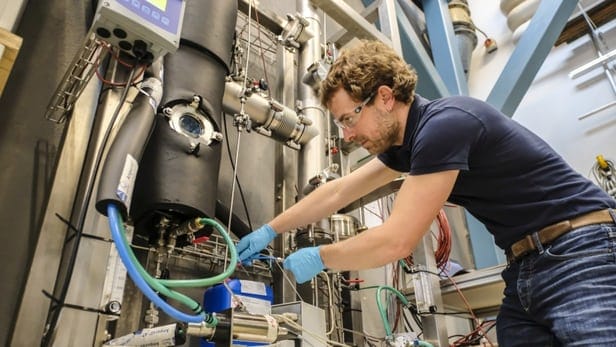While heat is widely thought to be energy in transit which only transfers from one medium to another, a group of Swiss researchers dare to change that notion. Researchers working at EMPA (Eidgenössische Materialprüfungs-und ForschungsAnstalt) or in English, the Swiss Federal Laboratories for Materials Testing and Research, have created a process that stores heat in the summers, and then, allows the user to extract it in the winter. Thus, enabling the user to transport it anywhere in the world physically!
This astonishing feat has been achieved using a new system of concentrated sodium hydroxide (NaOH) to store the thermal energy. The team then used some off-the-shelf components to capture the heat and a system to release it on demand. When dry sodium hydroxide mixes with water, an exothermic reaction ensues releasing high quantities of heat energy. And since NaOH is also extremely hygroscopic (having a great attraction for water molecules), it also attracts moisture in the air, heating the solution even further.
The researchers observed that if heat energy from a source is fed into the solution of sodium hydroxide and water, it makes the moisture readily evaporate. This process leads to the NaOH solution becoming concentrated and thus, efficiently stores the supplied energy. The best part is that the rich mixture can be kept stored for many months or years until the heat is liberated by exposing the NaOH to water again. The solution can also be moved about in containers and tanks to other areas where the heat energy is required.
The storage medium is a mixture of 50 percent NaOH solution trickling down a spiral pipe. It soaks up water vapors and conveys the generated heat into the pipe. The heat freely spreads to the outside via conduction, convection, and radiation. After this sodium hydroxide solution spills outside the heat exchanger spiral, where 30 percent of the mixture dilutes in the steamy atmosphere inside the system. It raises the water temperature in the pipe to around 50° C (122° F) for under floor heating.
The reverse of this process is evaporating the moisture from the NaOH solution when exposed to a heat source, which is then siphoned off and condensed. The solution exiting the heat exchanger has the 50 percent strength again. The researchers claim that this technique can be used to produce renewable solar collectors that are highly efficient.
The heated water is then transported to a geothermal probe for storage and retrieval until its temperature drops somewhere between 5 and 10° C (41 to 50° F), after which it is returned to drain the store. EMPA is looking to commercialize this prototype by creating a compact version for domestic household use very soon.
What are your thoughts on this ingenious heating device? Comment below!
Source: Empa


